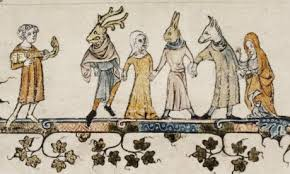Grateful Dead lyricist Robert Hunter points to the old English ballad “Nottamun Town” as the inspiration for his own approach to songwriting: The emotional power and vitality of the lyrics don’t require clarity of meaning and precise understanding because an emotional connection can be made with strong imagery and symbols whose meanings can be varied and open to personal interpretation.
The best description of “Nottamun Town” is offered by writer Steve Leggett: “It is a haunting, minor key ballad with surreal, riddle-like lyrics and a certain intangible feel of constant dread and menace, and yet has an almost whimsical sense of humor. The song itself builds on contradictions, where people look down to look up, where grey horses with green stripes are colored all black, where people talk all day but don’t utter a single word, where nothing will settle the dust even though it rains all day long. Although extremely descriptive, the lyrics to “Nottamun Town” are so elliptical that it is impossible to grasp firmly what the song might be about, but there is a certain apocalyptic sense about it, the feeling of a recent battle, of refugees on the road, of figures viewed through smoke and haze.”
Theories abound about its origins and meaning. It could be a product of the English Civil War (1642-1651) which began in Nottingham. The hard times leading up to the war had produced a popular literary theme: ‘The World Turned Upside Down.’ The fine arts also reflected this idea and there are many woodcuts dating from this period that illustrate cats chasing dogs, men wearing boots on their hands, and other reversals of the norm.
When I got there no one did I see
They all stood around me just looking at me
I called for a cup to drive gladness away
And stifle the dust for it rained the whole day
But the theory that seems to be most credible is that the lyrics emerged out
of the English Mummer’s Plays tradition which in turn had evolved from
community festivals that were as old as agriculture itself. Each festival
commemorated an agricultural activity and served to unite the community and
promote cooperation in planting and harvesting. When the Roman Empire spread to
the British Isles, the conquerors introduced
their Roman festivals without regard to local practicality. Saturnalia’s Feast
(for the god of sowing) was held in December, the Mediterranean sowing season. This
festival featured activities that were normally prohibited, and behaviors that
were the exact opposite of the norm; drunkenness and sexual licentiousness were
rampant, commoners occupied places of authority, slaves were served by their
masters, and songs and skits exchanged common sense themes for nonsensical
themes. The festival was a reminder that reversal was a necessary part of life:
In order to grow crops the earth had to be turned, so what was once on top is
now underneath.
But Saturnalia’s Feast had no real practical application in England since it took place in the middle of winter. The agricultural meaning was quickly lost but the skits and songs survived as social and political statements, both serious and humorous. Every December British peasants continued to dress up or down, blackened their faces and made the rounds of the manor houses where they’d sing, perform foolish skits, and beg for rewards. The performers were called “Mummers.” Anthropologists say that these types of rituals - 'rites of reversal' - are primarily found in societies undergoing internal stress and serve as a means to release tension and animosity between the classes.
Throughout English history the Mummer’s topsy-turvy performances referenced the plagues, politics and warfare, and any other important current event the effected the lives of commoners. It might be that the darkly bizarre lyrics of “Nottamun” reflect a town that has been infected with the Black Plague epidemic or perhaps ergot poisoning, a mold that attacks rye and causes hallucinations for all those who’ve ingested it. Whatever the origins of each indecipherable stanza by the 19th century only the mummer’s skits remained; in England the songs had been forgotten, their obscure and puzzling lyrics became irrelevant.
“Nottamun Town” did survive though, not in England but America. It was re-discovered in 1917 by British folklorist Cecil Sharp who heard it sung by cousins Una and Sabrina Ritchie in Knott County, Kentucky. Sharp published the Ritchie’s version in his 1932 book “Folksongs of the Southern Appalachians.” The Ritchie cousins had remembered the melody but they had to ask Una’s father for the lyrics before they performed it for Sharp. Una’s sister, the folk singer and dulcimer player Jean Ritchie (b.1922) wrote that: “The song has been in our family for many generations….Our family ancestors came over from England, Scotland, Ireland, the earliest ones we know of arrived in 1768. Our family still cherishes and sings the songs they brought with them…”
Jean Ritchie was also a Fulbright Scholar who spent time in England researching the songs that her family sang. Unfortunately her search for the origins of “Nottamun Town” in Nottingham came up empty. In 1999 she wrote in a letter to Roger McGuinn that “there is not another similar variant of 'Nottamun Town' in this country, or in England.” According to Lyle Lofgren however, another very similar version of the song called “Nottingham Fair” was found in Missouri archives. Since residents of the Ozark Mountains of Missouri were descendents of the folks who had migrated from the Appalachian Mountains in the early 19th century, Lofgren believes that Nottingham was the original inspiration. If true, in a prime example of the folk process, the lyrics became corrupted (or ‘distilled’ as McGuinn says) in the Appalachian Mountains.
The actual origins of the song may be as irrelevant as the true meaning of the lyrics. What matters is the emotional power of the phrases and imagery which continue to spellbind audiences even into the 21st century.
Sat down on a hard hot cold frozen stone
Ten thousand stood round me but I was alone
Took my hat in my hand to keep my head warm
Ten thousand was drowned that never was born.
As obscure and inscrutable as they may be, the words can still be riveting.
Sources: Steve Leggett (“When Up is Down” Allmusic Blog, June 2008), Roger McGuinn’s Folk Den (October 1999), Lyle Lofgren (“Inside Bluegrass,” Sept. 2003).
On American Pastimes: Elizabeth LaPrelle, Fairport Convention, and Mountain Home perform versions of “Nottamun Town.” Also we'll hear Bob Dylan’s “Masters of War” - an article in the book Baby, Let Me Follow You Down: The Illustrated Story of the Cambridge Folk Years by Eric von Schmidt & Jim Rooney explains how the Boston singer Jackie Washington learned Nottamun Town from Jean, did his own version at Gerde’s Folk City, where it was heard by Dylan who put the chords and melody to good use. Jackie Washington states:
“I found a song of Jean Ritchie's called ‘Nottamun Town.’ It's sung in a minor key against a major, like a lot of these mountain songs. It sounds nice, but I just couldn't do it, so I changed the tune to minor and made sort of a drone sound with the guitar. Dylan loved this. I was playing at Gerde's and he would come in every night and ask me to sing it. He went over to Vanguard, and Maynard gave him a copy of my record. The next time I heard my tune -- which was my tune -- it was ‘Masters of War.’"
Also featured will be some performances by Jean Ritchie and tracks from a new Jean Ritchie tribute cd: “Dear Jean; Artists Celebrate Jean Ritchie.”
For American Pastimes playlists: http://spinitron.com/radio/playlist.php?station=kzfr&showid=35












